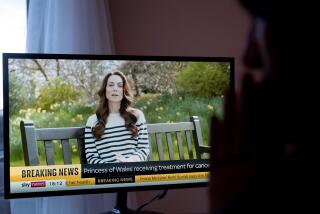Princess Ashraf Pahlavi dies at 96; twin sister of deposed shah of Iran
Iranian Princess Ashraf Pahlavi, the twin sister of the country’s deposed shah — who campaigned for women’s rights, shrugged off torture and declared that “monarchy is in the blood of the people” — has died in exile. She was 96.
Many in Iran before the country’s 1979 Islamic Revolution believed Princess Ashraf served as the true power behind her brother, Shah Mohammed Reza Pahlavi, and she played a pivotal role in the 1953 U.S.-engineered coup that installed him.
Immortalized in her royal prime by an Andy Warhol portrait with bright red lips and raven-black hair, Princess Ashraf’s years out of power more resembled a Shakespearean tragedy. Assassins killed her son on a Paris street just after the Islamic Revolution, her twin brother died of cancer shortly after, a niece died of a 2001 drug overdose in London and a nephew killed himself in Boston 10 years later.
Yet during decades of living under guard in exile, she defended her brother’s rule and held on to her royal past.
“At night, when I go into my room, that’s when all the thoughts come flooding in,” the princess told the Associated Press in a 1983 interview in Paris. “I try not to think. But the memories won’t leave you.”
Robert F. Armao, a longtime advisor to the princess in New York, said she died in Europe on Thursday. He declined to elaborate on the cause of her death. In Iran, local media reported her death relying on international reports. State television reported that she died in Monte Carlo and described her as being famous for being corrupt. Armao criticized that characterization.
“Her Highness did an awful lot for her country, whatever her human faults,” he said.
Born Oct. 26, 1919, Princess Ashraf was the daughter of the monarch Reza Shah, who came to power in a 1921 coup engineered by Britain and later was forced to abdicate after a 1941 invasion by Britain and Russia.
In 1953, the U.S. sought to orchestrate a coup that overthrew Iran’s popularly elected prime minister, Mohammed Mossadegh, over fears he was tilting toward the Soviet Union, and bring her brother to power.
But the shah was “a man of indecision,” according to a long-classified CIA account of the coup first published by the New York Times in 2000. So the plotters reached out to “the shah’s dynamic and forceful twin sister” who already had been in touch with U.S. and British agents, according to the account.
After “considerable pressure” by her and a U.S. general, the shah reportedly agreed and the coup went forward.
As her brother’s government ruled in opulence and its secret police tortured political activists, Princess Ashraf focused on women’s rights in an appointment to the United Nations. She and her sister, Shams, also were among the first Iranian women to be seen in public with their hair uncovered, breaking traditional norms in the Shiite country. Pahlavi decried honor killings and the practice of stripping widows of custody of their children. She also worked on diplomatic missions.
She traveled widely and became known for gambling on the French Riviera, the French press dubbing her “La Panthere Noire,” or “the Black Panther.” She survived a 1977 apparent assassination attempt in Cannes that killed her aide and wounded her chauffeur.
The political opposition during the shah’s era criticized Princess Ashraf over allegations of corruption and her highly publicized love affairs with Iranian actors and public figures.
After her brother’s 1979 overthrow in Iran’s Islamic Revolution, Princess Ashraf shuttled between homes in Paris, New York and Monte Carlo, and relied on bodyguards and a pet German shepherd for protection. “I am not a happy woman,” she told the Washington Post in 1980.
She published a memoir and remained outspoken, dismissing criticism of the family’s excesses. She told the Associated Press that under her brother, people in Iran had been “too free.”
Princess Ashraf married and divorced three times and had three children. She gradually faded from public view though she attended President Nixon’s funeral in 1994. She maintained she regretted nothing, and said that death had become a part of her.
“I had rather die being shot than die in my bed, from a sickness,” she told the Post.
But, she said, it was not in her hands.
Times staff writer Jill Leovy and the Associated Press contributed to this report.
MORE FROM OBITUARIES:
Pierre Boulez, a radical titan of contemporary music, dies at 90
Robert Flick dies at 84; NBC news producer survived Jonestown attack
Pat Harrington Jr. dies at 86; Emmy-winning actor played Schneider on ‘One Day at a Time’
More to Read
Start your day right
Sign up for Essential California for the L.A. Times biggest news, features and recommendations in your inbox six days a week.
You may occasionally receive promotional content from the Los Angeles Times.






